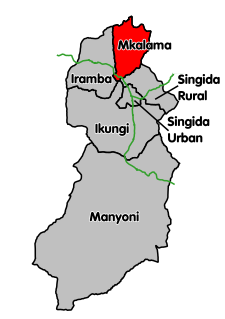Gumanga is an administrative ward in the Mkalama District of the Singida Region of Tanzania. According to the 2002 census, the ward has a total population of 9,896. According to the 2012 census, the population had increased to 10,948.
Ibaga is an administrative ward in the Mkalama District of the Singida Region of Tanzania. According to the 2002 census, the ward has a total population of 10,672. According to the 2012 census, the population had increased to 11,712.
Iguguno is an administrative ward in the Mkalama District of the Singida Region of Tanzania. According to the 2002 census, the ward had a total population of 21,617. The town is popular business center for crops like cereals and sunflower. It is arguably the most developed town in the district.There are a few schools both primary and secondary in the town. According to the 2012 census, the population had increased to 25,860.
Ilunda is an administrative ward in the Mkalama District of the Singida Region of Tanzania. According to the 2002 census, the ward has a total population of 19,465. According to the 2012 census, the population had increased to 21,622.
Kidaru is an administrative ward in the Kongwa district of the Singida Region of Tanzania. According to the 2002 census, the ward has a total population of 10,469.
Kinampanda is an administrative ward in the Iramba district of the Singida Region of Tanzania. According to the 2002 census, the ward has a total population of 13,699.
Kiomboi is an administrative ward in the Iramba district of the Singida Region of Tanzania. According to the 2002 census, the ward has a total population of 22,289.
Kisiriri is an administrative ward in the Iramba district of the Singida Region of Tanzania. According to the 2002 census, the ward has a total population of 10,245.
Mbelekese is an administrative ward in the Iramba district of the Singida Region of Tanzania. According to the 2002 census, the ward has a total population of 10,270.
Mpambala is an administrative ward in the Mkalama District of the Singida Region of Tanzania. According to the 2002 census, the ward had a total population of 10,882. According to the 2012 census, the population had increased to 11,192.
Msingi is an administrative ward in the Mkalama District of the Singida Region of Tanzania. According to the 2002 census, the ward has a total population of 6,439. According to the 2012 census, the population had increased to 7,289.
Mtekente is an administrative ward in the Iramba district of the Singida Region of Tanzania. According to the 2002 census, the ward has a total population of 16,312.
Mwanga is an administrative ward in the Mkalama District of the Singida Region of Tanzania. According to the 2002 census, the ward had a total population of 21,474. According to the 2012 census, the population had increased to 26,024.
Mwangeza is an administrative ward in the Mkalama District of the Singida Region of Tanzania. According to the 2002 census, the ward has a total population of 12,445. According to the 2012 census, the population had increased to 19,258.
Ndago is an administrative ward in the Iramba district of the Singida Region of Tanzania. According to the 2002 census, the ward has a total population of 12,332.
Nduguti is an administrative ward in the Mkalama District of the Singida Region of Tanzania. According to the 2002 census, the ward has a total population of 15,955. According to the 2012 census, the population had decreased to 8,638.
Ntwike is an administrative ward in the Iramba district of the Singida Region of Tanzania. According to the 2002 census, the ward has a total population of 14,221.
Shelui is an administrative ward in the Iramba district of the Singida Region of Tanzania. According to the 2002 census, the ward has a total population of 23,519.
Ulemo is an administrative ward in the Iramba district of the Singida Region of Tanzania. According to the 2002 census, the ward has a total population of 14,721.
Javane is an administrative ward in the Kongwa district of the Singida Region of Tanzania. According to the 2002 census, the ward has a total population of 9,896.



